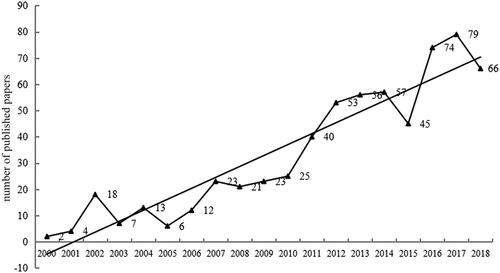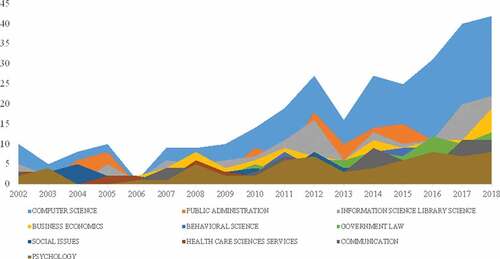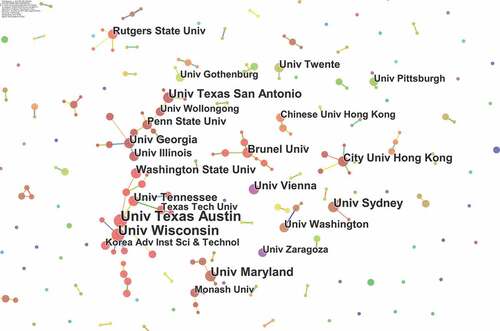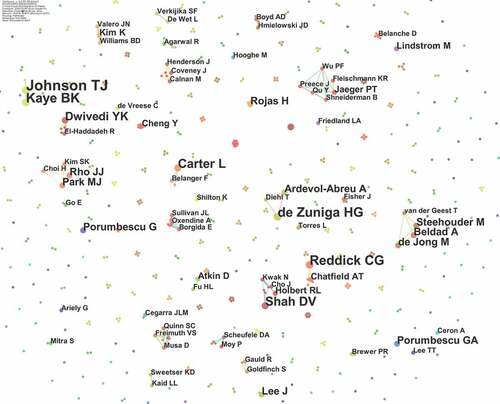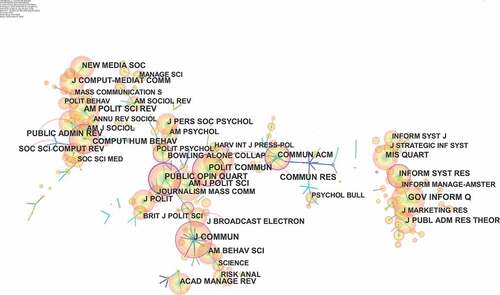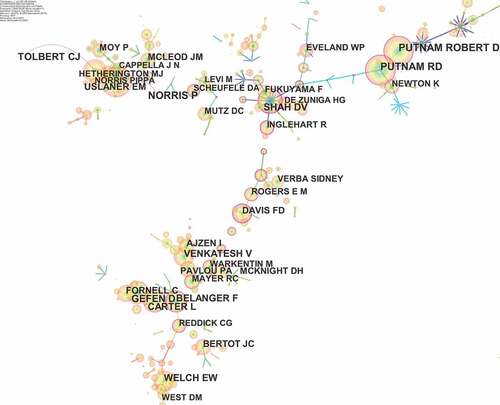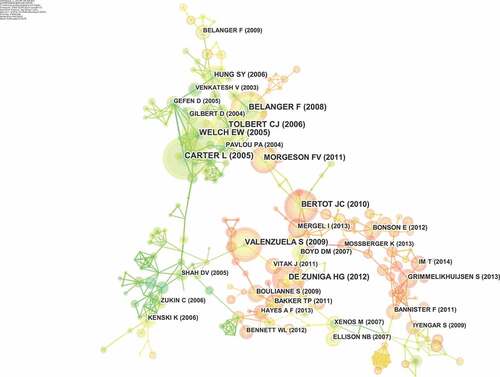ABSTRACT
The interaction between social media and government trust has been one of the most critical and dynamic research areas in the field of governance in recent years. In this paper, a scientometric analysis of 668 academic publications published from 2000 to 2018 related to social media and government trust is presented to characterise the intellectual landscape by identifying and visualising the evolution of the collaboration network, the co-citation network, and the emerging trends. The results show that the number of publications in this field has increased rapidly, and it has become an increasingly more popular interdisciplinary research subject. The most productive authors and institutions in this subject area are in the USA, China, Australia, and European countries. In this paper, we identify the most pressing topics of social media and government trust research as represented in the existing literature, which include the relationship between the Internet and governance, the impact of social media on government trust, and the contribution of social media to government trust and mitigation responses. The paper presents an in-depth analysis of social media and government trust research to better understand governance and the directions in this field that have emerged over the past 19 years.
Introduction
The world is rapidly entering a new era of revolutionary information exchange. Social media are increasingly becoming a necessity for human life. Its profound influence can even shape the relationship between the government and citizens and have a complex and diverse impact on government trust. Social media contain social networking applications such as Facebook and Google, microblogging services such as Twitter, blogs, and media sharing sites such as YouTube. According to Bertot, Jaeger, and Grimes (Citation2010), social media are collaborative and participatory by their very nature since they are defined by social interaction. They provide the ability for users to connect with each other and form communities to socialise, share information, or to achieve a common goal or interest.
Existing literature documents that social media tools, as ways for citizens to access public services and participate online in public affairs, are particularly increasingly affecting government trust (Kruikemeier & Shehata, Citation2017). The findings are mixed. For example, a recent work by (McAllister, Citation2016) suggests that use the social media platforms, such as Facebook, Twitter, etc., is associated with the restoration of the public trust in the government because of its potential to improve transparency and government performance. Kent Jennings and Zeitner (Citation2003) find that while the Internet would somehow exacerbate the existing inequalities in civic engagement, there is no clear evidence that using the Internet for political communication could lead to greater political distrust. Similarly, scholars suggest that the use of E-government has fallen short of its potential to improve the public trust in the government (Carter and Bélanger, Citation2005). In fact, the importance of social media in government trust was strengthened in the recent Facebook Third Quarter Report, particularly with respect to the recognition of the negative influence of Facebook on government trust. Addressing social media is arguably one of the most pressing issues facing public trust in the government, and the volume of relevant literature is growing rapidly.
Against this background, several studies have made progress in profiling the literature on public trust in the government and social media. Various angles have been presented in the analyses, including the relationship between political trust and social media (Welch, Citation2004), public expectations of their government and reactions to the impacts of government trust (Zhao, Citation2009), quantitative ways to evaluate the effects of social media on trust in the government (van Eeten & Mueller, Citation2013), and comprehensive reviews of social media and government trust (Andersen et al., Citation2010). Moreover, the subjectivity and individual preferences of previous studies leads to a lack of bibliometric quantitative analysis in these fields, such as collaboration analysis, co-citation analysis, keyword co-occurrence analysis, etc. Despite a wide range of publications linked to social media and government trust, the overall structure of its intellectual landscape is highly sparse.
Furthermore, there is a lack of comprehensive research on using CiteSpace to analyse the rapidly expanding social media and trust in the government literature. To provide a systemic and objective overview of the research on social media and government trust, this paper presents a visual analysis that provides more available and valuable research to future studies on social media and government trust in governance research. The research assessed is that published in the journals of the Web of Science from 2000 to 2018 by means of a scientometric analysis based on CiteSpace. Specifically, the research is guided by the following key goals. The first one is to assess the current research on social media and public trust in the government abroad with mapped knowledge; objectively reveal the journals, countries and authors; and deepen the knowledge on the highly quoted literature and hot topics in this field. Another one is to analyse the keywords that represent the shift in the studies and identify future opportunities to extend research, widen the horizon and thinking on social media and government trust, and provide references and lessons for the relevant research in this field.
Methodology and Data
Bibliometrics is a quantitative method of reviewing and describing published papers, which is helpful for researchers to evaluate academic research in a focal field (Rey-Martí, Ribeiro-Soriano, & Palacios-Marqués, Citation2016; Small, Citation1973). In addition, Bibliometric analysis examines the digital database of second-hand data from a quantitative and objective perspective (Albort-Morant & Ribeiro-Soriano, Citation2016). Therefore, this paper uses scientific mapping to explore the structure and evolution of the area of government trust and social media research. As shown in , this section discusses the procedures required to conduct a comprehensive quantitative bibliometric-based review.
This paper uses Citespace V and Java VIII as a visual and analytic research tool that is freely available online and was developed by Chaomei Chen. In constructing the network image, the cluster view and timezone view can all be used to analyse different information, including the knowledge structure, time span of keywords and evolutionary trends, respectively. The eight types of visualisation graphs represent the patterns of the scientific literature. The tool provides various functions to help users to specify the time period of the literature, choose the nodes, and set up thresholds on the same screen. Visual knowledge maps consist of nodes and links. Different nodes in a knowledge network map represent elements such as cited references, institutions, authors, and countries; and the links between nodes represent collaborative or co-citation relationships. The node colour represents the year of publication or connection, and the size of each node represents the total number of citations. The larger the node is, the higher the frequency of citations is. In addition, various relationships of the underlying network can also be represented by the links.
To obtain valid and comprehensive target articles, we set topics of the title search as ‘Internet’ or ‘Social media’ and ‘Trust in Government’ or ‘Government Trust’ or ‘Political Trust’. Several restrictions were set before the topic search. First, we selected the Web of Science (WOS) core collection rather than all databases so that articles would be high quality and influential in the field. Second, the time span was set from 2000 to 2018 because the core journals associated with social media and government trust in social science and psychology started in 2000. Third, the Science Citation Index Expanded (SCI) and the Social Sciences Citation Index (SSCI) were used as citation indexes to make the samples more comprehensive. Last, 668 articles were selected from the WOS database, even though WOS does not include all papers about social media and public trust in the government. The references from collected records cover almost every important article in the research field, and crucial points can be highlighted on the knowledge map of cited references, authorship and institutional analysis.
Results and Analysis
Research Outputs and Their Categories
The progression of published papers related to social media and government trust during the 19-year period is shown in . A clear upward trend over time can be observed, indicating the increased role of scientific research in social media and government trust. According to the growth curve of the social media and government trust research, three reasons can be given as follows. First, compelling evidence shows that social media are developing rapidly. Social media not only influences the political efficacy but also contributes to the changes in political trust (Cook & Gronke, Citation2005). Second, social media has become an important tool through which world citizens can buy and sell goods, access data, browse the news and express their opinions (Wang, Cai, Mou, & Shi, Citation2018).Third, the past decade has also witnessed that social media has become an important channel for citizens to participate in politics, given that traditional media has always been under the strict control of the regime (Tang & Huhe, Citation2014). Nevertheless, social media and government trust research is still a relatively young field of study with the bulk of these articles having just appeared in the last ten years (shown in ).
With the surge of social media and Government trust issues, the evolving and interdisciplinary nature of Internet use and Government trust research has also resulted in the need to map the current knowledge development. presents the top ten research fields that focus on the relations in social media and government trust research. In recent years, more studies are on computer science and psychology. In addition, at the end of the 2010s, social media and government trust had become a research topic ranging from information science (e.g. computer science information systems, communications and computer science artificial intelligence) to public administration (e.g. political science, management and regional urban planning). Efforts made in reviewing and analysing articles on social media and government trust disciplines thus become important in understanding what knowledge has been generated so far and what will be the evolutionary direction for future research. Rather than exploring the relations among social media and government trust as a guide to policy making, this article presents an overview of the increase in social media and government trust research and takes stock of what this increase in publications has generated in terms of knowledge.
The Collaboration Network of the Social Media and Government Trust Research
Collaboration analysis is critical to understanding scholarly communication and knowledge diffusion (Chen, Citation2006). Each bibliographic record analysed by CiteSpace contains its title, abstract, and authors with addresses. These authors are called co-authors, and coauthorship indicates a collaborative relationship between co-authors. For example, a record shows that an article published in 2016, entitled ‘A social media text analytics framework for double-loop learning for citizen-centric public services: A case study of a local government Facebook use’, has co-authors from the two institutions (Department of Public Administration, the University of Texas at San Antonio; and Faculty of Engineering and Information Sciences, Wollongong University). In this case, the USA and Australia would be connected by lines in the country collaboration network. In this study, the collaboration analysis focuses on identifying the research community and principal countries/institutes/authors in social media and government trust field. We advance a dynamic structure for the contributing research community, which can serve as a useful guide for new researchers and for those seeking potential cooperation and reviewers in the multidisciplinary research area of social media and government trust.
Country Collaboration Network
The top 10 countries with the largest portions of contributions to the total output are shown in . The USA is the largest contributor, publishing 246 papers and is followed by England (65). The two dominant countries in Asia are China (57) and South Korea (29), ranking 3 and 5, respectively, in terms of their publication counts. England plays a central role in the stable cooperation between various countries according to its highest BC (0.64) in 2002, and it includes 65 articles in 19 years. European countries (e.g. Spain and Germany) also play crucial roles in making connections with other countries according to their high BCs (0.12 and 0.17, respectively). Obviously, USA is a leader in the development of information technology; China and South Korea have experienced rapid development of information and communication technologies (ICTs); and Canada, Australia and Spain have made breakthroughs in social media research with high research outputs over the last 19 years. Overall, the development of social media and government trust research over the past 19 years and the number of outputs are associated with a number of research institutions, the availability of research funding, and the proportion of those that have an ICT focus.
Table 1. Top countries based on frequency
Institution Collaboration Network
The institution collaboration network consisted of 132 institutions and 98 collaboration links from 2000 to 2018 and is shown in . According to the relatively tight structure and closer relationships, the institutional cooperation network indicates a relatively high maturity within the research community. The top 10 institutions that made the majority of the contributions to the total outputs are presented in . The University of Texas, Austin tops the list with 14 publications and the other institutions with high numbers of publications are the University of Wisconsin System (13), the University of Maryland (9) and the University of Sydney (8). The University of Texas, Austin plays a crucial role in making connections with other institutions according to its high betweenness centrality. It can be seen that the USA is the largest contributor in social media and government trust research with 7 institutions. Moreover, the City University of Hong Kong is a high-frequency institution in the network, and four central institutions are linked to it.
Table 2. Top 10 institutions based on frequency
Author Collaboration Network
The author collaboration network for social media and government trust research consisted of 215 authors and 423 collaboration links and is presented in . Johnson TJ, evidently, is one of the most influential scholars in the field of social media and political trust; he has worked on research in political communication, public opinion, and new communication technologies. For example, he revealed the associations between motivations for using the Internet and political trust, and showed that political attitudes can predict the motivation for public Internet use. Furthermore, some authors (Carter, Kaye, Reddick, and Shah) developed closer relationships since the 2000s. The author collaboration network of social media and government trust is in a state of partial concentration and overall decentralisation, and the author collaboration network is relatively weak. As far as the departments are concerned, most of the authors in the top 10 list worked in business and economics, technology and communication, or political science and public administration departments, which is consistent with the social media and government trust research output categories in .
The Co-citation Network of Social Media and Government Trust Research
Co-citation network analysis was first put forward by Small (Citation1973), and a co-citation occurs when two literatures appear in the bibliography of a third cited documents. The process of mining the co-citation relationship of a document space data set can be regarded as the co-citation analysis of documents, which uses the expectation maximisation algorithm based on a series of attributes, including the citation frequency and betweenness centrality (BC). Notably, BC is the metric of a node that measures how likely it is that an arbitrary shortest path in a network will go through a node, which shows the ability of a node to make connections with other nodes in a network. The half-life of an article is defined as the number of years that over 50% of the total citations were made during these years since its publication. In this study, by exploring the underlying clusters of the most cited journals/authors/references, we can find the most influential points in the knowledge structure.
Journal Co-citation Network
To outline the set of journals that have served the social media and government trust research community over the last 19 years, the co-citation network at journal level is shown in . In total, 404 different publications were found, illustrating a diverse body of knowledge that influences studies on social media and government trust. The top ten journals with over 97 co-citations are listed in . The Journal of Communication is the most prominent journal, with 136 co-citations, and it is followed by Government Information Quarterly (126) and Human Communication Research (121). In addition, most of these journals are in the communication engineering field, and two, Public Administration Review and America Political Science Review, are correlated with the fields of psychology and sociology. In terms of BC, Public Opinion Quarterly and Political Communication have the highest BC ratios (0.68 and 0.47, respectively). Other journals with high relative BC ratios are Communication of the ACM (0.45), the Journal of Communication (0.29), and Computer Human Behaviour (0.25). These three journals, therefore, are the core nodes that make connections to other nodes in the journal co-citation network of social media and government trust research.
It should be pointed out that in this analysis, most of these journals in the social media and government trust domain fall into three subdomains, which include management, environmental science and political science. In particular, the Journal of Communication is the top journal in the communication field, which also includes Communication and Information Theory, Communication Software and Services, and Protocol and Algorithms for Communications. It aims to provide a forum for researchers, practitioners, and professionals who are working in the field of communications to network and discourse on research and development and professional practice in related fields. Government Information Quarterly focuses on how policies affect government information flows, the availability of government information, the use of technology, etc. Within the broad spectrum, particular topics are concerned with the intersection of policy, information technology, government, and the public. Specific research areas include the valuation of sustainable agriculture and development, environmental-integrated technology, integrating the relations to social media and the satisfaction with governmental environmental protection. Sustainability is concerned with the environmental, cultural, economic and social sustainability of human beings; and it provides an advanced forum for studies related to sustainability and sustainable development. The Journal of Cleaner Production addresses and discusses theoretical and practical cleaner production and encompasses the environmental and sustainability issues of corporations, governments, education institutions, regions and societies. As shown in , the most prolific journals in social media and government trust research do not necessarily have a larger impact and are not cited more frequently. However, journals with higher effective factors may have higher co-citation frequencies.
Table 3. Top 10 most cited journals with their co-citation frequencies
Author Co-citation Network
The findings in this section show the frequently cited authors. It should be pointed out that in this analysis, all the publications of a particular author are combined into one, which means that only the first author is considered. The merged author co-citation network that contributes to the social media and government trust literature is shown in , which contains 545 nodes and 1472 co-citation links. The top-cited author is Dhavan V. Shah, and David Gefen is a key node in the network due to his high BC (0.68), which is a measure associated with the transformative potential of a communication science contribution. To be succinct, David Gefen tends to bridge different stages of the development of the social media and government trust field. lists the top 10 authors with citation frequencies greater than 70. Compared with the authors presented in , a highly consistent correlation is observed between the top 10 most cited authors and the top 10 most productive authors.
Table 4. Top 10 most cited authors with their co-citation frequencies
The Document Co-citation Network
Document analysis examines the network of cocited references to obtain the key authors and articles contributing to knowledge transfer. As observed, one of the major mechanisms for governments using social media falls under the umbrella term e-government. In , an article entitled ‘The utilization of e‐government services: citizen trust, innovation and acceptance factors’ is the most cited reference. The document forms a comprehensive model of factors that influence citizens’ adoption of e-government initiatives, and then it showed that perceived ease of use, compatibility and trustworthiness are significant predictors of citizens’ intention to use an e-government service. Research on trust and risk in e-government adoption was performed by Bélanger and Carter (Citation2008). They proposed a model of e-government trust composed of disposition to trust, trust of the Internet (TOI), trust of the government (TOG) and perceived risk. These two articles lay a foundation for researching the e-government model of social media and government trust. Another two of the most cited references are Welch, Hinnant, and Moon’s (Citation2004) and Tolbert & Mossberger’s (Citation2006) articles. Both of the articles discuss the effects of e-government on trust in and satisfaction with the government. Valenzuela, Park, and Kee (Citation2009) find positive relationships between the intensity of Facebook use and students’ life satisfaction, social trust, civic engagement, and political participation (Gil De Zúñiga, Jung, & Valenzuela, Citation2012). Facebook is one of the most popular social network sites among college students in the US, and it is related to attitudes and behaviours that enhance individuals’ social capital. Morgeson III, VanAmburg, and Mithas (Citation2010) suggest that although e-government may help improve citizens’ confidence in the future performance of an agency, it does not yet lead to greater satisfaction with an agency interaction nor does it correlate with greater generalised trust in the federal government. Overall, the studies in this network discuss the social media and government trust issue on a global scale and focus more on the e-government and political facets of governance issues.
Contrary to the upper part of the network in , there is another obvious group in the co-citation network that focuses more on the citizen trust and Internet. Im, Cho, Porumbescu, and Park (Citation2012) is authored by the most influential scholar in the field of governance. He works in Seoul Seoul National University in the Department of Public Administration. This article investigates how the levels of citizens’ trust in the government and compliance are affected by citizens’ Internet use. The results suggest that the more time individuals spend on the Internet, the lower their degree of trust in the government and the lower their level of citizen compliance. However, the results also suggest that such negative effects of the Internet can be moderated through increased Internet usage among citizens. Notably, a number of researchers have paid special attentions to the effect of transparency on trust in government. Grimmelikhuijsen, Porumbescu, Hong, and Im (Citation2013) stated that transparency is a key value for trustworthy governments. The document compares the effect of transparency on trust in the government between the Netherlands and South Korea. The results reveal that national cultural values play a significant role in how people perceive and appreciate government transparency.
Keyword Co-occurrence Analysis
The keyword co-occurrence analysis in our study adopted author keywords as statistical objects. A statistical analysis of the clustering of keywords linked to social media and government trust is provided in . According to the major keywords, the main topics of social media and government trust study can be shown in the following three aspects regarding the aspect factors on Internet user, e-government dimension and the social media factors.
Table 5. Top 10 most cited references with their co-citation frequencies
Table 6. Keyword clustering
From the perspective of Internet users themselves, their tendency to trust and level of Internet experience directly determine their degree of trust in their online interactions with the government. There are some differences in the tendency to trust among different groups of people, which depends on whether people are willing to rely on others and bear the risk of trusting others, that is, whether it is optimists or pessimists. In this way, some people express deep trust in e-government and online government services while others are very cautious and do not easily trust before obtaining more information. There are two opposite views on the impact of citizen Internet experience on government online trust. Some scholars believe that more frequent citizen Internet use lowers their trust in online organisations, which may be related to the more information that people know, the more they can feel the risk that the network may bring at any time. Other scholars think that citizens’ network experience affects their level of trust in network technology, and then it affects their trust in online transaction processing, thereby forming Internet-based learning trust. In addition, the family environment, growth experience, education background, learning and imitation of Internet users will affect their trust in the Internet. Furthermore, the environment of the whole Internet space will also affect their trust in the whole Internet space.
In particular, the quality of previous online transaction experiences determines citizen satisfaction and trust in government online services. In fact, many online service users who have not dealt with the government online regard the former reputation of the government as an important indicator of whether the government is trustworthy. In general, governments with high reputations are honest and responsible in their daily operations, and they can consider the interests of partners when making decisions, which enhance their credibility. In addition, such governments generally do not take opportunistic actions, such as disclosing citizens’ private information to a third party, etc., and Internet users will not hesitate to give personal information to these reputable government websites. In addition, the actual performance of the government, such as its efficiency, service level, openness and transparency, and a series of factors will also significantly affect the citizens’ recognition and trust in the government.
In general, the information quality on social media is also one of the important criteria for users to evaluate the credibility of government services. In addition to the accuracy of information, researchers found that the usefulness of information is also an important criterion for citizens’ trust. The security of government websites is also the basic factor for citizens to evaluate the credibility of government websites. The emergence of a security mechanism will significantly increase the credibility of government websites. When citizens disclose personal information to government websites, they are concerned about the security of their personal privacy the most, which also affects their overall level of trust in government websites and even government organisations.
Emerging Trends of Social Media and Government Trust Research
Bursts are terms that appear many times in a short period or with a high use frequency. The trend and frontier of the research field can be judged according to the frequency change of bursts. According to hotspot analysis and the bursts provided in , we present three types of social media and government trust studies.
Table 7. Top 20 keywords with the strongest citation bursts
The relationship of the Internet and government governance. The Internet is considered as an important factor for government governance. Today, government governance is mainly embodied in digital governance, such as e-government. For example, (Porumbescu, Citation2016) argued that greater use of e-government websites is negatively related to citizens’ satisfaction and perceptions of public sector trustworthiness. Conversely, the use of a public sector social media accounts is positively related to satisfaction and perceptions of the public sector’s trustworthiness. In fact, information quality is a key determinant of public trust (Cappella & Jamieson, Citation1996). ICT (information and communication technology) impacts four domains within the public sector, which are capabilities, interactions, orientations and value distributions (Andersen et al., Citation2010). Against this background, several indexes have been developed to measure social media elements that mostly affect the quality of the government governance. All these indicators have been widely used to assess the projected impacts of social media on government trust at a national scale, as well as regionally and locally.
The impact of social media on government trust. Since the 2000s, more studies related to the impacts of social media on government trust have been carried out, which has resulted in the broadening of the scope in this field. First, the direct and indirect effects of social media on government trust have been examined (e.g. changing the potential values of social media and influencing citizens’ acceptance and trust when participating in government social media services). Second, social media and government trust have been evaluated (e.g. the relationship of trust between the government and the public on government websites). To address the relevant articles, it is important to explore multiple antecedents or factors of citizens’ trust with a major consideration for using social media as a technology platform for e-government services (Hong & Liang, Citation2015; Ling, Hong, & Zhang, Citation2011). A model that identifies individual characteristics, government factors, risk factors and social media characteristics that includes multiple antecedents of citizens’ trust in government social media services has been proposed. In recent years, social media are being used as a technology platform to provide government services. Moreover, extreme factors impacting government trust have been examined using the technology acceptance model (TAM), which is an adaptation of the Theory of reasoned action (Alsaghier & Hussain, Citation2012; Hendrickson, Massey, & Cronan, Citation1993). In particular, social media are being used as a technology platform to provide government services, contrary to the previous studies where the Internet was used as a tool to provide services by static government websites (Chen, Zhu, Tomaszewski, & Maceachren, Citation2007). As a result, the issue of how to improve government trust by using social media has been a growing interest to researchers.
The contribution of social media to government trust and mitigation responses. Social media are used as a technology platform in context of government social media services. According to (Beldad, van der Geest, de Jong, & Steehouder, Citation2012), the characteristics of any technology influence citizens’ trust in using that technology. Similarly, (Park, Choi, Kim, & Rho, Citation2015) mentioned that citizens’ trust towards the government can increase if the government understands the characteristics of social media and utilises them appropriately. Thus, it is important to identify those technological characteristics that may influence citizens’ trust in using government social media services. In particular, individuals use online information about the performance of their governments as a heuristic to adjust their political attitudes and determine how much they can trust the authority. There are many possible channels underlying the relationship between social media and trust in the government. First and foremost, Internet use is likely impact individuals’ perceptions of government transparency, which may further affect the level of trust in the government. (Best & Wade, Citation2009) argue that social injustice, atrocities and official corruption can easily be exposed on the Internet due to its fast speed, low communication costs and anonymity. Second, some studies also find that citizens’ good experience with e-government services is positively associated with e-government satisfaction, leading to the increase of trust in the government (Welch et al., Citation2004). Additionally, there is evidence that the use of social media can either increase or decrease individuals’ political efficacy, which in turn contributes to the changes in political trust (Hoffman & Thomson, Citation2009). In the context of government social media, government organisations post many information about their services and other activities; therefore, there may be a need for structural assurance to attract a good number of citizens to participate.
Conclusion
First, based on 668 publications, the output from 2000 to 2018 indicates strongly increasing trends. Significant points emerged, and a systematic overview of social media and government trust was presented. Second, the distribution of the research field suggested the high priority of computer science, information science library science, behavioural science and public administration issues. Moreover, social media and government trust has involved multidisciplinary research. Third, research on social media and government trust is dominated by the USA, England and China, all of which have the most productive authors and institutions. Especially, the USA plays a central role in the stable cooperation between various countries and their research institutions, and these connections have been gradually strengthened over the 21st century. However, according to the relatively tight structure and very close relationships, the institutional cooperation network indicates a relatively high maturity within the research community. Fourth, the findings of the most cited authors are slightly inconsistent with those of the productive authors, although there is a high level of conformity between the most cited journals and the most prolific journals. Finally, these studies build upon the three emerging trends of social media and government trust, which are the relationship between the Internet and government governance, the impact of social media on government trust and the contribution of social media to government trust and mitigation responses. Last but not least, with the weight of the scientific evidence beginning to suggest that the loss of trust in authorities was unavoidable, how to strengthen the public trust and public satisfaction will become a promising research direction.
Although academic research has been conducted in this field, there are still many substantial gaps that need to be filled. On the basis of combining the previous research results on social media and government trust to expand on the breadth and scope of this research, further research could be considered as follows. First, some new ideas are emerging, such as social media intensity; the frequency of browsing newspapers, official media, social networking sites, Blogs and foreign websites; interest in politics and satisfaction with the status quo. The relationship between the frequency of Internet use and public trust is no longer discussed. Second, most articles still discuss the development of social media and government trust from the perspective of developed countries while less pay attention to developing countries. Although social media and government trust is expected to jeopardise sustainable development in both developed and developing countries, it is more challenging for the latter because the level of trust in the government at the local level is higher than that at the national level in most Asian societies, and most Chinese citizens are more trusting of their central government and are less trusting of their local governments (Wu & Wilkes, Citation2018). Third, most existing studies have separately discussed the impacts of traditional media (such as TV, telephone, newspaper, etc.) and new media (such as mobile phones, computers, etc.) on government trust; thus, we call for research investigating the different impacts of the media on the development of government trust.
Some inherent limitations of the contents and methods of this study are listed as follows. First, researchers usually tend to cite their own work and many high-quality papers, which may impact the number of citations from top journals. Future research may consider excluding self-citations. Second, since all data collected in this paper are from English-language sources, future research may obtain more comprehensive results by including papers written in other languages. Future studies may consider social media and government trust research among the studies published in other languages. In addition, the results show that China rivals the USA in research results. We expect to conduct an in-depth analysis of the studies through the CNKI in the future. Third, we can provide a comprehensive-field visualised knowledge map of the social media and government trust studies in combination with different knowledge fields and visualisation technology. For example, UCINET can be used to examine various properties of collaborative networks. To expand our research results, we also intend to apply the literature review technique to social media and government trust research.
Disclosure Statement
No potential conflict of interest was reported by the authors.
Additional information
Notes on contributors
Peishan Tong
Peishan Tong is a PhD candidate in school of international relations and public affairs at Fudan University. Her research interests focus on the relationship between citizen and government.
Zhiping Song
Zhiping Song is a PhD candidate in school of international relations and public affairs at Fudan University. His research interests focus on e-government and the relationship between the Internet and public management.
References
- Albort-Morant, G., & Ribeiro-Soriano, D. (2016). A bibliometric analysis of international impact of business incubators. Journal of Business Research, 69(5), 1775–1779.
- Alsaghier, H. M., & Hussain, R. (2012). Conceptualization of trust in the e-government context: A qualitative analysis. IGI Global, 23(2), 528–557.
- Andersen, K. N., Henriksen, H. Z., Medaglia, R., Danziger, J. N., Sannarnes, M. K., & Enemærke, M. (2010). Fads and facts of e-government: A review of impacts of e-government (2003-2009). International Journal of Public Administration, 33(11), 564–579.
- Bélanger, F., & Carter, L. (2008). Trust and risk in e-government adoption. The Journal of Strategic Information Systems, 17(2), 165–176.
- Beldad, A., van der Geest, T., de Jong, M., & Steehouder, M. (2012). A cue or two and I’ll trust you: Determinants of trust in government organizations in terms of their processing and usage of citizens’ personal information disclosed online. Government Information Quarterly, 29(1), 41–49.
- Bertot, J. C., Jaeger, P. T., & Grimes, J. M. (2010). Using ICTs to create a culture of transparency: E-government and social media as openness and anti-corruption tools for societies. Government Information Quarterly, 27(3), 264–271.
- Best, M. L., & Wade, K. W. (2009). The Internet and democracy: Global catalyst or democratic dud? Bulletin of Science, Technology & Society, 29(4), 255–271.
- Cappella, J. N., & Jamieson, K. H. (1996). News frames, political cynicism, and media cynicism. The Annals of the American Academy of Political and Social Science, 546(1), 71–84.
- Carter, L., & Bélanger, F. (2005). The utilization of e-government services: Citizen trust, innovation and acceptance factors. Information Systems Journal, 15(1), 5–25.
- Chen, C. (2006). CiteSpace II: Detecting and visualizing emerging trends and transient patterns in scientific literature. Journal of the American Society for Information Science and Technology, 57(3), 359–377.
- Chen, C., Zhu, W., Tomaszewski, B., & Maceachren, A. (2007). Tracing conceptual and geospatial diffusion of knowledge. Online Communities and Social Computing. Springer Berlin Heidelberg.
- Cook, T. E., & Gronke, P. (2005). The skeptical American: Revisiting the meanings of trust in government and confidence in institutions. The Journal of Politics, 67(3), 784–803.
- Gil De Zúñiga, H., Jung, N., & Valenzuela, S. (2012). Social media use for news and individuals’ social capital, civic engagement and political participation. Journal of Computer-mediated Communication, 17(3), 319–336.
- Grimmelikhuijsen, S., Porumbescu, G., Hong, B., & Im, T. (2013). The effect of transparency on trust in government: A cross-national comparative experiment. Public Administration Review, 73(4), 575–586.
- Hendrickson, A. R., Massey, P. D., & Cronan, T. P. (1993). On the test-retest reliability of perceived usefulness and perceived ease of use scales. MIS Quarterly, 45(4), 227–230.
- Hoffman, L. H., & Thomson, T. L. (2009). The effect of television viewing on adolescents’ civic participation: Political efficacy as a mediating mechanism. Journal of Broadcasting & Electronic Media, 53(1), 3–21.
- Hong, D. C., & Liang, S. (2015). Media characteristics and social networks-enabled knowledge integration in cooperative work. Procedia Computer Science, 60(4), 246–255.
- Im, T., Cho, W., Porumbescu, G., & Park, J. (2012). Internet, trust in government, and citizen compliance. Journal of Public Administration Research and Theory, 24(3), 741–763.
- Kent Jennings, M., & Zeitner, V. (2003). Internet use and civic engagement: A longitudinal analysis. Public Opinion Quarterly, 67(3), 311–334.
- Kruikemeier, S., & Shehata, A. (2017). News media use and political engagement among adolescents: An analysis of virtuous circles using panel data. Political Communication, 34(2), 221–242.
- Ling, H., Hong, D. C., & Zhang, C. H. (2011). Research on tacit knowledge integration: A synthesis of social ties and TMS. Knowledge Management Research & Practice, 9(3), 256–262.
- McAllister, I. (2016). Internet use, political knowledge and youth electoral participation in Australia. Journal of Youth Studies, 19(9), 1220–1236.
- Morgeson III, F. V., VanAmburg, D., & Mithas, S. (2010). Misplaced trust? Exploring the structure of the e-government-citizen trust relationship. Journal of Public Administration Research and Theory, 21(2), 257–283.
- Park, M. J., Choi, H., Kim, S. K., & Rho, J. J. (2015). Trust in government’s social media service and citizen’s patronage behavior. Telematics and Informatics, 32(4), 629–641.
- Porumbescu, G. A. (2016). Linking public sector social media and e-government website use to trust in government. Government Information Quarterly, 33(2), 291–304.
- Reddick, C. G., Chatfield, A. T., & Ojo, A. (2017). A social media text analytics framework for double-loop learning for citizen-centric public services: A case study of a local government Facebook use. Government Information Quarterly, 34(1), 110–125.
- Rey-Martí, A., Ribeiro-Soriano, D., & Palacios-Marqués, D. (2016). A bibliometric analysis of social entrepreneurship. Journal Business Research, 69(5), 1651–1655.
- Small, H. (1973). Co‐citation in the scientific literature: A new measure of the relationship between two documents. Journal of the American Society for Information Science, 24(4), 265–269.
- Tang, M., & Huhe, N. (2014). Alternative framing: The effect of the Internet on political support in authoritarian China. International Political Science Review, 35(5), 559–576.
- Tolbert, C. J., & Mossberger, K. (2006). The effects of e-government on trust and confidence in government. Public Administration Review, 66(3), 354–369.
- Valenzuela, S., Park, N., & Kee, K. F. (2009). Is there social capital in a social network site?: Facebook use and college students’ life satisfaction, trust, and participation. Journal of Computer-mediated Communication, 14(4), 875–901.
- van Eeten, M. J., & Mueller, M. (2013). Where is the governance in Internet governance? New Media & Society, 15(5), 720–736.
- Wang, H., Cai, T., Mou, Y., & Shi, F. (2018). Traditional resources, Internet resources, and youth online political participation: The resource theory revisited in the Chinese context. Chinese Sociological Review, 50(2), 115–136.
- Welch, E. W. (2004). Linking citizen satisfaction with e-government and trust in government. Journal of Public Administration Research and Theory, 15(3), 371–391.
- Welch, E. W., Hinnant, C. C., & Moon, M. J. (2004). Linking government satisfaction with e-government and trust in government. Journal of Public Administration Research and Theory, 15(3), 371–391.
- Wu, C., & Wilkes, R. (2018). Local-national political trust patterns: Why China is an exception. International Political Science Review, 39(4), 436–454.
- Zhao, D. (2009). The mandate of heaven and performance legitimation in historical and contemporary China. American Behavioral Scientist, 53(3), 416–433.


